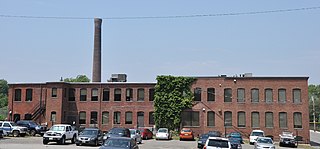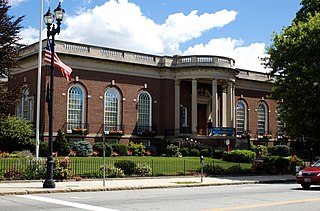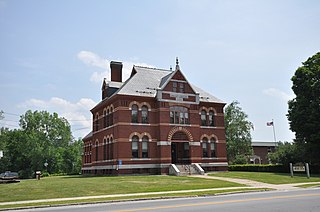
The Wilcox, Crittenden Mill, also known as Wilcox, Crittenden Mill Historic District, is a 17-acre (6.9 ha) property in Middletown, Connecticut that was listed on the National Register of Historic Places in 1986. It was the location of the Wilcox, Crittenden company, a marine hardware firm. The historic district listing included four contributing buildings and three other contributing sites.

The Ace Art Company is a historic commercial and industrial building in Reading, Massachusetts. Built in 1924, the single-story brick building is the only Art Deco building in Reading. It was listed on the National Register of Historic Places in 1985.

The Beth Eden Baptist Church is a historic Baptist church building at 84 Maple Street in Waltham, Massachusetts. Built in 1891, it is a fine local example of Romanesque Revival architecture and is further notable as the oldest church on Waltham's South Side. The church was added to the National Historic Register of Historic Places in 1989. Its Settled Pastor is Rev. Dr. Esther Pearson.

St. Charles Borromeo Church is a former parish of the Catholic Church in Waltham, Massachusetts. It is noted for its historic church building, completed in 1922. A high quality example of Italian Renaissance Revival architecture, it is emblematic of the shift on Waltham's south side from a predominantly Protestant population to one of greater diversity. The building was listed on the National Register of Historic Places in 1989.

The American Waltham Watch Company Historic District encompasses the former factory of the Waltham Watch Company, the leading American watch manufacturer of the 19th century and the city's largest employer. Located on Crescent Street and the banks of the Charles River, the surviving elements of its manufacturing facility date from the 1870s to the 1910s, and include particularly fine industrial Romanesque architecture. The buildings have been converted to a variety of commercial, industrial and residential uses since they ceased being used for watchmaking in the 1950s. The complex was listed on the National Register of Historic Places in 1989.

The American Watch Tool Company is a historic factory complex at 169 Elm Street in Waltham, Massachusetts. The company was founded in 1877 as a spin-off from the successful American Watch Company, and was used for the production of watchmaking tools until 1904. The four-building complex traces the evolutionary history of this business. The factory was listed on the National Register of Historic Places in 1989.

The United States Watch Company is a historic factory complex at 260 Charles Street in Waltham, Massachusetts. Built in 1886 and enlarged in 1901, it represents one of the most successful spinoffs of the American Waltham Watch Company, Waltham's dominant watchmaker of the late 19th century. When the complex was listed on the National Register of Historic Places in 1989, it was the last watch factory left in the city.

Boston Manufacturing Company Housing are historic residential housing blocks at 380–410 and 153–165 River Street in Waltham, Massachusetts. The housing was for the Boston Manufacturing Company (BMC), the earliest modern manufacturing facility in the United States. The housing was built in the nineteenth century and the two blocks of buildings were separately added to the National Register of Historic Places in 1989.

The Central Square Historic District is a historic district encompassing the central town common of the city of Waltham, Massachusetts, and several commercial buildings facing the common or in its immediate vicinity. The common is bounded by Carter, Moody, Main, and Elm Streets; the district includes fourteen buildings, which are located on Main, Elm, Lexington, and Church Streets, on the north and east side of the common. The district was listed on the National Register of Historic Places in 1989.

The Waltham Public Library is the public library of the city of Waltham, Massachusetts. Its main location is in the Francis Buttrick Library, an architecturally significant Georgian Revival building built in 1915, funded by a bequest from Francis Buttrick, a major landowner in the city. The building was listed on the National Register of Historic Places in 1989.

The Jefferson–Chalmers Historic Business District is a neighborhood located on East Jefferson Avenue between Eastlawn Street and Alter Road in Detroit, Michigan. The district is the only continuously intact commercial district remaining along East Jefferson Avenue, and was listed on the National Register of Historic Places in 2004.

The Babcock Block is a historic commercial building at 596 Main Street in Worcester, Massachusetts. Built in the 1860s, it is a rare example of granite construction in the period. It was listed on the National Register of Historic Places in 1980.

The Moody Street Historic District is a historic commercial district at Moody and Crescent Streets in Waltham, Massachusetts. It consists of eight commercial properties facing Moody Street as it runs south from the Charles River toward Newton. The area was developed between about 1880 and 1950, and is a reminder of the city's economic prosperity in that time. The district was listed on the National Register of Historic Places in 1990.

The Harrington Block is a historic commercial and retail building at 376–390 Moody Street in Waltham, Massachusetts. The three-story brick building was built 1884-85 by Charles Harrington, a local real estate speculator who was also employed by the Boston Manufacturing Company. It is one of the city's few Queen Anne commercial building, and is the oldest commercial building on Moody Street to escape major alteration. The ground floor originally housed retail establishments, while the upper floors were residential.

The Gale–Banks House is a historic house at 935 Main Street in Waltham, Massachusetts. This farmhouse was built c. 1798, and is one of the finest Federal style houses in the city. It is also significant for its association with Waltham native son, Governor of Massachusetts, and general of the American Civil War, Nathaniel Prentice Banks, who purchased it in 1855 and made it is home until his death in 1894. The house was listed on the National Register of Historic Places in 1990.

Flanley's Block is a historic commercial building at 349–353 Main Street in Wakefield, Massachusetts, US. Built about 1895, it is a well-preserved local example of late 19th-century Italianate commercial architecture. The building was listed on the National Register of Historic Places in 1989.

The Hamilton Mill Brick House is a historic house at 16 High Street in Southbridge, Massachusetts. Built c. 1855 by the Hamilton Woolen Mill Company, it is one of a small number of brick company housing units to survive from that time. The house was listed on the National Register of Historic Places on June 22, 1989.

The Joshua Sears Building is a historic building in Kirkland, Washington, located at the northwest corner of Market Street and Seventh Avenue, Kirkland's historic commercial core. It was built in 1891 by Boston philanthropist and capitalist, Joshua Sears, who was heavily invested in Peter Kirk's Great Western Iron and Steel Company and was the town site's largest landowner. As a result of the Panic of 1893, the steel mill and the bank intended to occupy this building never opened but the Sears building survives today as a reminder of what might have been in Kirkland. It is an early example of Beaux-Arts architecture in the Northwest, where Victorian and Romanesque Revival styles were still predominant in commercial buildings. On August 3, 1982, it was added the National Register of Historic Places. In December 2015 the building was purchased by local attorney Simeon Osborn and his wife Monica Hart, who stated they plan to keep the current business and residential tenants.

The Conant Public Library is the public library of Winchester, New Hampshire. It is located at 111 Main Street, in a fine Victorian Romanesque Revival building erected in 1891, funded by a bequest from Winchester resident Ezra Conant. The building's design, by Springfield, Massachusetts architect, J. M. Currier, is based on his design of the 1886 library building in Brattleboro, Vermont, and is one of the most architecturally distinguished buildings in Cheshire County. It was listed on the National Register of Historic Places in 1987.

The Briggs Carriage Company is a historic industrial complex at 14 and 20 Cedar Street in Amesbury, Massachusetts. Built before 1890, these two buildings are a surviving reminder of the city's late 19th century prominence as a major carriage manufacturing center. They were listed on the National Register of Historic Places in 2007.























